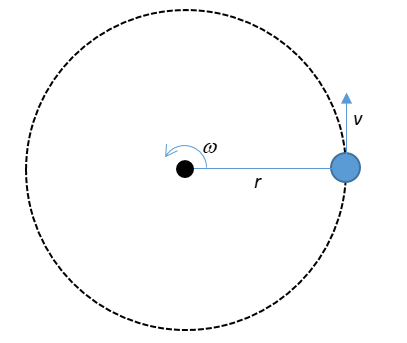
An aeroplane is flying with a uniform speed of 100 m/s along a circular path of radius 100 m. the angular speed of the aeroplane will be
A. 1 rad/s
B. 2 rad/s
C. 3 rad/s
D. 4 rad/s
Answer
218.7k+ views
Hint:When a body is moving in a circular path then the position of the body along the circular path changes with time. As we know, the rate of change in the linear position of the body with respect to time is called the linear velocity. The rate of change of the angular position with respect to time is called the angular velocity.
Formula used:
\[v = \omega r\]
where v is the linear velocity, \[\omega \] is the angular velocity and r is the distance of the point from the axis of rotation.
Complete step by step solution:
It is given that the body is whirled in a horizontal circle. The radius of the circle is given as 100 m. The linear velocity of the body is given as 100 m/s. We need to find the angular velocity of any point on a circular path.

Image: Particle’s circular motion
Let the linear velocity of the body is \[\omega \]. The distance of the body from the axis of rotation, i.e. from the centre of the circular path is equal to the radius of the circular path.
\[r = 100\,m\]
\[\Rightarrow v = 100\,m/s\]
When a body is moving in a given circular path then the position of the body along the circular path changes with time. The rate of change in the linear position of the body with respect to time is called the linear velocity, v.
The linear velocity of the body is linearly related to the angular velocity of the body in the circular path as,
\[v = \omega r\]
Putting the values, we get the angular velocity of the body in circular orbit as,
\[\omega = \dfrac{v}{r}\]
\[\Rightarrow \omega = \left( {\dfrac{{100}}{{100}}} \right)rad/s\]
\[\therefore \omega = 1\,rad/s\]
Hence, the angular velocity of the body is equal to1 rad/s.
Therefore, the correct option is A.
Note: We should be careful while using the relation between the linear velocity and the angular velocity as it is for the instantaneous velocity. So, if we find the linear velocity of the accelerated body in a circular path then the obtained linear velocity will be corresponding to the angular velocity at that instant in time.
Formula used:
\[v = \omega r\]
where v is the linear velocity, \[\omega \] is the angular velocity and r is the distance of the point from the axis of rotation.
Complete step by step solution:
It is given that the body is whirled in a horizontal circle. The radius of the circle is given as 100 m. The linear velocity of the body is given as 100 m/s. We need to find the angular velocity of any point on a circular path.

Image: Particle’s circular motion
Let the linear velocity of the body is \[\omega \]. The distance of the body from the axis of rotation, i.e. from the centre of the circular path is equal to the radius of the circular path.
\[r = 100\,m\]
\[\Rightarrow v = 100\,m/s\]
When a body is moving in a given circular path then the position of the body along the circular path changes with time. The rate of change in the linear position of the body with respect to time is called the linear velocity, v.
The linear velocity of the body is linearly related to the angular velocity of the body in the circular path as,
\[v = \omega r\]
Putting the values, we get the angular velocity of the body in circular orbit as,
\[\omega = \dfrac{v}{r}\]
\[\Rightarrow \omega = \left( {\dfrac{{100}}{{100}}} \right)rad/s\]
\[\therefore \omega = 1\,rad/s\]
Hence, the angular velocity of the body is equal to1 rad/s.
Therefore, the correct option is A.
Note: We should be careful while using the relation between the linear velocity and the angular velocity as it is for the instantaneous velocity. So, if we find the linear velocity of the accelerated body in a circular path then the obtained linear velocity will be corresponding to the angular velocity at that instant in time.
Recently Updated Pages
Two discs which are rotating about their respective class 11 physics JEE_Main

A ladder rests against a frictionless vertical wall class 11 physics JEE_Main

Two simple pendulums of lengths 1 m and 16 m respectively class 11 physics JEE_Main

The slopes of isothermal and adiabatic curves are related class 11 physics JEE_Main

A trolly falling freely on an inclined plane as shown class 11 physics JEE_Main

The masses M1 and M2M2 M1 are released from rest Using class 11 physics JEE_Main

Trending doubts
JEE Main 2026: Application Form Open, Exam Dates, Syllabus, Eligibility & Question Papers

Derivation of Equation of Trajectory Explained for Students

Hybridisation in Chemistry – Concept, Types & Applications

Understanding the Angle of Deviation in a Prism

Understanding Collisions: Types and Examples for Students

Understanding Atomic Structure for Beginners

Other Pages
JEE Advanced Marks vs Ranks 2025: Understanding Category-wise Qualifying Marks and Previous Year Cut-offs

Units And Measurements Class 11 Physics Chapter 1 CBSE Notes - 2025-26

NCERT Solutions For Class 11 Physics Chapter 8 Mechanical Properties Of Solids

Motion in a Straight Line Class 11 Physics Chapter 2 CBSE Notes - 2025-26

NCERT Solutions for Class 11 Physics Chapter 7 Gravitation 2025-26

How to Convert a Galvanometer into an Ammeter or Voltmeter




